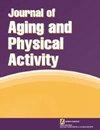将远程锻炼作为以证据为基础的老年人太极拳防跌倒干预措施的替代交付模式的预流行可行性。
IF 1.4
4区 医学
Q4 GERIATRICS & GERONTOLOGY
引用次数: 0
摘要
目前亟需采取预防跌倒的干预措施,以帮助医疗服务不足、难以接触到的农村老年人。以证据为基础的太极拳:移动改善平衡 (TJQMBB) 计划可减少老年人跌倒。这项在 COVID-19 大流行前进行的研究评估了对老年人进行为期 16 周的远程 TJQMBB 干预的可行性和影响。讲师们通过 Zoom 为 52 名老年人(平均年龄 ± SD 68.5 ± 7.7 岁)开设了六堂远程 TJQMBB 课程,授课地点分别在一所大学和四个社区。几乎所有计划课程(97%)都已完成。平均出席率为 61%。没有发生不良事件。忠实度从一般到良好(平均 67%)。41%的课程出现了技术中断。参与者的步速、平衡能力、下肢力量和体重指数均有所提高。远程 TJQMBB 是可行的,并对结果产生了积极影响。这项研究为建立一种新的提供模式迈出了第一步,这种模式有可能扩大 TJQMBB 的覆盖范围并使其得以维持。本文章由计算机程序翻译,如有差异,请以英文原文为准。
Prepandemic Feasibility of Tele-Exercise as an Alternative Delivery Mode for an Evidence-Based, Tai Ji Quan Fall-Prevention Intervention for Older Adults.
There is a critical need for fall-prevention interventions to reach medically underserved, hard-to-reach, rural older adults. The evidence-based Tai Ji Quan: Moving for Better Balance (TJQMBB) program reduces falls in older adults. This pre-COVID-19 pandemic study assessed the feasibility and impact of a 16-week tele-TJQMBB intervention in older adults. Instructors led six tele-TJQMBB classes via Zoom for 52 older adults (mean age ± SD 68.5 ± 7.7 years) at one academic and four community sites. Nearly all (97%) planned sessions were delivered. Average attendance was 61%. There were no adverse events. Fidelity was fair to good (mean 67%). Forty-one percent of sessions experienced technical disruptions. Participants improved their gait speed, balance, lower-extremity strength, and body mass index. Tele-TJQMBB was feasible with a positive impact on outcomes. This study was the first step toward establishing an additional delivery mode that could potentially expand TJQMBB's reach and maintenance.
求助全文
通过发布文献求助,成功后即可免费获取论文全文。
去求助
来源期刊
CiteScore
2.60
自引率
6.70%
发文量
105
审稿时长
>12 weeks
期刊介绍:
The Journal of Aging and Physical Activity (JAPA) is a multidisciplinary journal that publishes peer-reviewed original research reports, scholarly reviews, and professional-application articles on the relationship between physical activity and the aging process. The journal encourages the submission of articles that can contribute to an understanding of (a) the impact of physical activity on physiological, psychological, and social aspects of older adults and (b) the effect of advancing age or the aging process on physical activity among older adults.
In addition to publishing research reports and reviews, JAPA publishes articles that examine the development, implementation, and evaluation of physical activity programs among older adults. Articles from the biological, behavioral, and social sciences, as well as from fields such as medicine, clinical psychology, physical and recreational therapy, health, physical education, and recreation, are appropriate for the journal. Studies using animal models do not fit within our mission statement and should be submitted elsewhere.

 求助内容:
求助内容: 应助结果提醒方式:
应助结果提醒方式:


